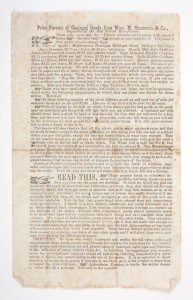Disclaimer: This post contains adult content. If there are any children reading this blog, or anyone else who wishes to avoid the “hidden” side of the 19th century, this post isn’t for you. But for the rest of our readers, we could use your help learning more about a new acquisition.
The AAS curator of graphic arts, Lauren Hewes, recently purchased this circular letter, headlined “Price Current of Conjugal Goods from Mme. M. Simmons, & Co.” On one side, the letter advertises a wide range of condoms (male and female), “French Male Safes” (condoms made from a mixture of India rubber and gutta percha), “apex envelopes,” “womb veils” (an early form of diaphragm), and other contraceptive devices, along with “Male and Female Yarns, Ticklers rings, Surprises, 50 cents each.”
The other side of the letter describes a list of (presumably) pornographic or erotic prints that are also available for purchase via mail order, with long lists of titles of images, some specifically intended “for Ladies.” “There is no vulgarity in these fine works of art,” the letter proclaims, “although the skilful artist exhibits every form of the sweet and captivating being as her Creator made her,” adding that these prints “decorate the first galleries of art in New York.” In additio n to prints, the letter also advertises items “just introduced into the States,” which are described as follows:
n to prints, the letter also advertises items “just introduced into the States,” which are described as follows:
They are glass of the size of a grain of Rice, and within exhibit to the naked eye a life-sized picture of bewitching and lovely attitude. … I sell them, nicely encased in pen holders at $1.00 each, one or more. There is but one person represented in each glass, and are not offensive.
These erotic novelty items, which apparently featured an image of a nude figure underneath a small magnifying lens, are of a piece with a wide range of similar goods that were available by retail in American cities (and by mail elsewhere) through much of the nineteenth century. (The letter’s italicized insistence that they only contain one figure is intended to underscore the fact that they only depicted naked individuals, and did not show actual sex acts.)
All of the goods advertised here—contraceptives, erotic prints, aphrodisiacs, and sexual novelty items—could be obtained by sending cash and postage stamps to Mme. Simmons at Station D, New York City (a post office in Manhattan located in “Bible House,” the headquarters building of the American Bible Society at 9th Street and 4th Avenue). Ordered items would be sent to purchasers “through the mail … in such a disguised manner that no one can detect or suppose the contents of the letter,” using “patent French letter seals proof against water and steam….” Even though information about contraception was relatively easy to find in mid-nineteenth-century America, this concern with discretion is understandable.
But we have some questions, which we were hoping this blog’s readers could help us answer.
- When was this letter printed?
We know that it was after the end of the Civil War, as it refers to Simmons as the author of a pamphlet titled Fifteen Minutes Conversation with Married Ladies, revised in 1865. It also contains several references of a fairly topical nature—such as one to a print titled “Sinking the 290,” which most likely is a double entendre referring to the sinking of the Confederate warship Alabama in 1864.
But was the letter printed before 1873, when Anthony Comstock, the founder of the New York Society for the Suppression of Vice, persuaded Congress to pass the Comstock Act, which made it illegal to deliver through the mail any “obscene, lewd, or lascivious,” or any information or items related to birth control? That is, was Simmons operating in the more freewheeling period from 1865-73, or was she advertising and mailing her goods directly under the nose of the nation’s most tireless anti-obscenity crusader (or vigilante, depending on one’s point of view), when people were regularly paying stiff fines and serving long prison sentences for sending “obscene” material through the mail?
- And what are “yarns”? The letter advertises “yarns for males, yarns for females,” and “rubber yarns,” but offers few hints as to what they might be.
- Finally, do any of you know anything about Mme. Simmons (almost certainly not a real name)? Was this name a front for another operator in the nineteenth-century smut trade?

One thought on “Prints for a Different Parlor”